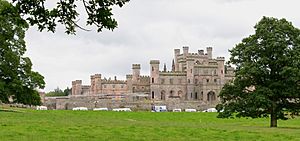William Lowther, 2nd Earl of Lonsdale facts for kids
Quick facts for kids
The Earl of Lonsdale
|
|
|---|---|
 |
|
| Postmaster General | |
| In office 9 September 1841 – 30 December 1845 |
|
| Monarch | Victoria |
| Prime Minister | Sir Robert Peel, Bt |
| Preceded by | The Earl of Lichfield |
| Succeeded by | The Earl of St Germans |
| Lord President of the Council | |
| In office 27 February 1852 – 17 December 1852 |
|
| Monarch | Victoria |
| Prime Minister | The Earl of Derby |
| Preceded by | The Marquess of Lansdowne |
| Succeeded by | The Earl Granville |
| Personal details | |
| Born | 21 July 1787 |
| Died | 4 March 1872 (aged 84) |
| Nationality | British |
| Political party | Tory |
William Lowther, 2nd Earl of Lonsdale (born July 21, 1787 – died March 4, 1872) was an important British politician. He was a member of the Tory party.
He was known as Viscount Lowther from 1807 until 1844. He was also a member of the Privy Council (PC), a group of advisors to the King or Queen. He was also a Fellow of the Royal Society (FRS), which means he was recognized for his contributions to science.
Early Life and Family
William Lowther was the oldest son of William Lowther, 1st Earl of Lonsdale. His mother was Lady Augusta. His younger brother was Henry Lowther.
William went to Harrow, a famous school. Later, he studied at Trinity College, Cambridge, a well-known university.
Political Journey
William Lowther started his political career in 1808. He was elected to Parliament as a Member of Parliament (MP) for Cockermouth. He held this seat until 1813.
He also represented other areas in Parliament, including Westmorland and Dunwich.
In 1818, he became a member of the Privy Council. This meant he could advise the monarch.
He held several important government jobs:
- From 1828 to 1830, he was the First Commissioner of Woods and Forests. This role involved managing royal lands and forests.
- From 1834 to 1835, he served as Treasurer of the Navy and Vice-President of the Board of Trade. The Treasurer of the Navy managed the navy's money, and the Vice-President of the Board of Trade helped with business and trade.
In 1841, he joined the House of Lords. This happened through a special process called a writ of acceleration. It allowed him to become a Lord while his father was still alive.
From 1841 to 1845, he was the Postmaster General. This job meant he was in charge of the postal service.
In 1844, his father passed away, and William became the 2nd Earl of Lonsdale.
His last major government role was Lord President of the Council in 1852. In this job, he was part of the government's main decision-making group, called the Cabinet.
Besides his political roles, he was also chosen as a Fellow of the Royal Society in 1810. This showed his interest in science and knowledge. He also served as the Lord Lieutenant of Cumberland and Westmorland from 1844 to 1868. These roles involved representing the monarch in those counties.
Later Life and Legacy
Lord Lonsdale never married. However, he had children whom he supported financially in his will. Two of his children were Marie Caroline and Frances Lowther. Another child was Francis William Lowther.
He passed away in London on March 4, 1872, at the age of 84. His nephew, Henry, became the next Earl of Lonsdale.
William Lowther left a large amount of money in his will. His children, Francis William and Frances, each received a significant sum.
A marble statue of him was made by Edward Bowring Stephens. It can be seen at Hughenden Manor in Buckinghamshire.
Images for kids



